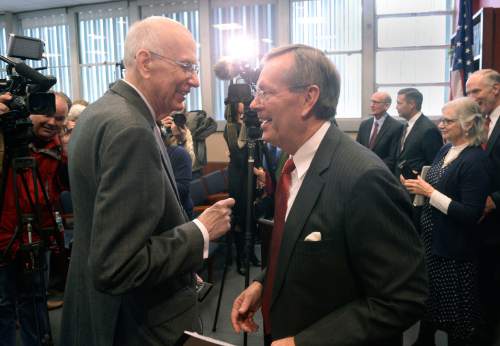This is an archived article that was published on sltrib.com in 2016, and information in the article may be outdated. It is provided only for personal research purposes and may not be reprinted.
For the first time in two decades, both Republicans and Democrats in Utah will use neighborhood caucuses instead of primaries to help select presidential nominees.
Parties foresee huge turnouts despite the change — Republicans expect 200,000 (partly because of a first-in-the-nation opportunity to vote online for White House candidates) and Democrats hope to see 50,000.
Changes that now are expected to draw big crowds grew largely out of controversy surrounding Utah's 2010 U.S. Senate race.
Tea party Republicans used caucuses to elect enough state convention delegates to defeat three-term incumbent Sen. Bob Bennett — even though he had high poll ratings among all Utahns. He was considered one of the nation's most conservative senators, but was not right-wing enough for tea partyers. Sen. Mike Lee, R-Utah, eventually won the race.
It scared Sen. Orrin Hatch, R-Utah, enough that, two years later, he spent millions to attract more people to caucuses to avoid Bennett's fate.
Also, The Church of Jesus Christ of Latter-day Saints that year — and in every election year since — read letters from the pulpit urging caucus attendance, warning in stronger-than-usual language that political minorities could rule otherwise. It canceled all church meetings during caucuses so members could attend the political gatherings.
Citing the extreme right's bushwhacking of Bennett, a group called Count My Vote began collecting signatures for a petition drive to replace caucuses with direct primaries.
The Legislature stopped the petition effort, led by former Gov. Mike Leavitt, by adopting a compromise, called SB54. It allows candidates to qualify for a primary election either through the traditional caucus-convention system, or by gathering enough signatures. However, the Republican and Constitution parties have sued, seeking to throw out the petition option and keep just caucuses.
Amid that fight, Republicans made a number of changes to caucuses to help improve turnout as proof that they do not favor a small group of insiders. Among those tweaks is this year's online voting option.
Caucus attendance has boomed in recent years, driven largely by the push from Utah's predominant faith to encourage participation and Hatch's multimillion-dollar investment four years ago.
Republicans figure they used to have a statewide attendance at caucuses of about 40,000 people. In 2012, that soared to 125,000. It dropped back to 60,000 to 70,000 in the nonpresidential year of 2014 — but still was 50 percent above normal.
Democrats, meanwhile, figured in 2012 that they tripled their caucus attendance to between 15,000 and 20,000. In 2014, it dropped back to 10,000 to 15,000.
With bigger attendance numbers, and given their continuing fight to keep the caucus system, Republicans last year decided against holding a presidential primary — and instead opted to combine presidential voting with caucuses. (Democrats held a presidential caucus in 2012 when President Barack Obama was essentially unopposed).
Republicans adopted a resolution saying caucuses could attract "attendance levels surpassing historical trends and without taxpayer funding." It said holding one event instead of two would respect "voter time and family schedules."
Mitt Romney — who won 93 percent of the Utah GOP primary vote in 2012 — criticized that change.
He contended caucuses would mean "tens of thousand fewer voters will participate" than if the nomination was decided in a primary. He added, "It's clear to me that the more citizens involved, the better the result."
Republicans expect participation may be higher this year than the last presidential election, partly because Utah has a chance to affect the undecided national race. The Beehive State vote often has come after nominees were essentially already chosen.
The last time Utahns voted in a primary season when it truly mattered was 2008 (on Super Tuesday). That year, Democrats favored Obama by a 57 percent to 37 percent margin over Hillary Clinton. Romney took 90 percent of the GOP vote against John McCain.



